Unit: AM/FM Stereo Receiver
Manufacturer: Sherwood
Model: S-7210
SN: 511645
Today I'm showcasing a Sherwood S-7210 AM/FM stereo receiver that came in for restoration. This model was introduced in 1974 and produces 26 watts per channel into 8 ohms with less than 0.6% total harmonic distortion. The damping factor is 30. The list price in 1974 was $299.95 (Ref. High Fidelity Magazine, September 1974, page 27).
The Sherwood S-7210 is a service-friendly receiver. Each board can be easily accessed for servicing.
Selector & Pre-Amp Board
The selector & pre-amp board has two solid tantalum capacitors (C501a, C501b) and twelve aluminum electrolytic capacitors (C503a, C503b, C504a, C504b, C505a, C505b, C506a, C506b, C512, C513, C514, C515). The solid tantalum capacitors are installed in the input signal path and I replaced them with modern low leakage Nichicon UKL e-caps. The ordinary aluminum e-caps C505a and C505b installed in the output signal path were replaced with high-quality film polyester WIMA caps. And, the remaining aluminum capacitors were replaced with low impedance Nichicon UPW caps.
The original e-caps were tested with an Atlas ESR70 capacitance meter and the results are below. Five of the fourteen capacitors are outside of factory spec.
Test results on original capacitors removed from the selector & pre-amp board:
C501a: rated capacitance – 4.7uF, measured – 5.3uF, ESR – 1.58Ω, deviation: +13%
C501b: rated capacitance – 4.7uF, measured – 4.9uF, ESR – 1.92Ω, deviation: +4%
C503a: rated capacitance – 22uF, measured – 28uF, ESR – 1.12Ω, deviation: +27%
C503b: rated capacitance – 22uF, measured – 28uF, ESR – 1.04Ω, deviation: +27%
C504a: rated capacitance – 33uF, measured – 36uF, ESR – 0.55Ω, deviation: +9%
C504b: rated capacitance – 33uF, measured – 34uF, ESR – 0.66Ω, deviation: +3%
C505a: rated capacitance – 1uF, measured – 1.3uF, ESR – 2.9Ω, deviation: +30%
C505b: rated capacitance – 1uF, measured – 1.2uF, ESR – 2.9Ω, deviation: +20%
C506a: rated capacitance – 10uF, measured – 11uF, ESR – 1.35Ω, deviation: +10%
C506b: rated capacitance – 10uF, measured – 11uF, ESR – 1.42Ω, deviation: +10%
C512: rated capacitance – 33uF, measured – 41uF, ESR – 0.72Ω, deviation: +24%
C513: rated capacitance – 33uF, measured – 41uF, ESR – 0.81Ω, deviation: +24%
C514: rated capacitance – 10uF, measured – 11uF, ESR – 1.39Ω, deviation: +10%
C515: rated capacitance – 10uF, measured – 11uF, ESR – 1.42Ω, deviation: +10%
Two NPN transistors (TR502a & TR502b) installed on this board are Toshiba 2SC1000. This transistor is known to get noisy over time. I replaced the original 2SC1000 transistors with modern low-noise Fairchild KSC1845s. The new transistor has the same pinout as the original one.
Selector & pre-amp board - before and after
Main Amp & Power Supply Board
The power supply, tone control amplifier, and main amplifier are all located on a single PCB.
The power supply circuit provides -11.3V DC to the tuner board, and balanced power to the main power amplifier from the bridge rectifier and two filter capacitors. The circuit has two aluminum electrolytic capacitors (C807, C808) and two axial filter capacitors (C805, C806). The two aluminum e-caps were replaced with low impedance and high-reliability Nichicon UPW caps. Both axial 4700uF/35V filter capacitors were replaced with new 4700uF/40V Vishay 021ASM series caps. I usually don't replace large filter capacitors in vintage gears unless their ESR is high or the measured capacitance exceeds the nominal one by more than +/- 10%. But it makes sense in this particular case since the ESR of each original filter cap is relatively high and the measured capacitance is very low in comparison to the nominal value.
Test results on original capacitors removed from the power supply circuit:
C805: rated capacitance – 4700uF, measured – 2362uF, ESR – 0.13Ω, deviation: -50%
C806: rated capacitance – 4700uF, measured – 2214uF, ESR – 0.14Ω, deviation: -53%
C807: rated capacitance – 33uF, measured – 32uF, ESR – 3.8Ω, deviation: -3%
C808: rated capacitance – 33uF, measured – 33uF, ESR – 3.8Ω, deviation: 0%
The tone control circuit has six aluminum electrolytic capacitors (C901a, C901b, C902a, C902b, C906a, C906b) installed in the signal path, and two filtering aluminum e-caps (C908 and C909). Four ordinary aluminum e-caps with a nominal capacitance of 1uF were replaced with film polyester WIMA caps to improve the signal-to-noise ratio. The other two e-caps with a nominal capacitance of 4.7uF were replaced with modern low leakage Nichicon UKL caps. And the remaining filtering aluminum capacitors were replaced with low impedance Nichicon UPM caps.
Note, that one of the original capacitors installed in this circuit completely failed the test (C906b, open circuit).
Test results on original capacitors removed from the tone control circuit:
C901a: rated capacitance – 1uF, measured – 1.3uF, ESR – 1.66Ω, deviation: +30%
C901b: rated capacitance – 1uF, measured – 1.2uF, ESR – 2.4Ω, deviation: +20%
C902a: rated capacitance – 1uF, measured – 1.2uF, ESR – 2.2Ω, deviation: +20%
C902b: rated capacitance – 1uF, measured – 1.2uF, ESR – 2.1Ω, deviation: +20%
C906a: rated capacitance – 4.7uF, measured – 5.1uF, ESR – 1.8Ω, deviation: +9%
C906b: rated capacitance – 4.7uF, measured – open circuit
C908: rated capacitance – 220uF, measured – 298uF, ESR – 0.14Ω, deviation: +36%
C909: rated capacitance – 470uF, measured – 508uF, ESR – 0.08Ω, deviation: +8%
The main amplifier circuit has nine aluminum electrolytic capacitors: C601a, C601b, C604a, C604b, C605a, C605b, C606a, C606b, and C611. Two of them (C601a and C601b) are installed in the input signal path. I replaced them with film polyester WIMA caps to improve the signal-to-noise ratio. The other e-caps were replaced with low impedance Nichicon UPW/UHE caps.
Note, that two out of nine original capacitors installed in this circuit completely failed the test (C605b and C611, open circuit). Also, the measured capacitance of e-cap C604a is very close to the nominal but its ESR is very high.
Test results on original capacitors removed from the main amplifier circuit:
C601a: rated capacitance – 1uF, measured – 1.2uF, ESR – 1.74Ω, deviation: %
C601b: rated capacitance – 1uF, measured – 1.2uF, ESR – 2.4Ω, deviation: %
C604a: rated capacitance – 33uF, measured – 34uF, ESR – 8.3Ω, deviation: %
C604b: rated capacitance – 33uF, measured – 33uF, ESR – 3.5Ω, deviation: %
C605a: rated capacitance – 33uF, measured – 33uF, ESR – 2.8Ω, deviation: %
C605b: rated capacitance – 33uF, measured – open circuit
C606a: rated capacitance – 100uF, measured – 87uF, ESR – 0.19Ω, deviation: %
C606b: rated capacitance – 100uF, measured – 86uF, ESR – 0.22Ω, deviation: %
C611: rated capacitance – 4.7uF, measured – open circuit
The first stage of the main amplifier circuit is a differential pair amplifier consisting of two amplifying transistors with a common emitter: TR601a/TR602a (left channel) and TR601b/TR602b (right channel). The original PNP transistors installed in these positions are 2SA640. These transistors are not on my list of notorious transistors prone to failure. However, before I started servicing this receiver I measured the DC offset across the speaker terminals and noticed a relatively high (but still safe) voltage in the right channel. The measured DC offset in the left channel was ~14mV (perfectly good) but in the right channel, the measured voltage was ~55mV. This voltage should be as close to zero volts as possible within +/- 50mV. Usually, if this voltage is relatively high (but still within a safe range) the problem might be with mismatched transistors installed in the differential amplifier. So, I unsoldered the original 2SA640 transistors and tested each pair with Atlas DCA55 semiconductor analyzer. The measured current gain of two transistors TR601a and TR602a (left channel) was 542 and 491, respectively. It gives an ~10% difference between them. Not too bad, but remember that transistors installed in the differential amplifier are supposed to be closely matched to operate properly in the circuit. Then, I measured the current gain of two transistors TR601b and TR602b installed in the right channel. The measured gain was 563 and 449, respectively. It gives ~25% difference between them which is rather substantial.
I replaced all original 2SA640's with modern Fairchild KSA992 transistors. Before installation, each pair of KSA992 transistors was carefully matched by current gain and base-emitter voltage. After the new transistors were installed the DC offset on each channel became close to 0V within +/- 10mV.
I also noticed that the body of two resistors (R803 and R915) is damaged. The R803 is installed in the power supply circuit, and the R915 is in the tone control circuit. I didn't see any signs of overheating though. So, I am not sure what caused their damage. Despite the body being damaged the measured resistance of R803 and R915 is still very close to the nominal resistance. It makes sense to replace these two resistors as a part of preventive maintenance. The original R803 was replaced with a new Vishay power metal film resistor. And the R915 was replaced with a new KOA Speer metal film resistor.
The body of two original resistors R803 and R915 is damaged
Main amp & power supply board - before and after
Dial and Meter Lamps
The dial and meter lamps in this unit have been already replaced with warm white LED lamps by the owner.
New dial and meter lamps - warm white LEDs
Output Power Test
The final output power test was performed at the end of my restoration. The receiver was loaded with a low inductance 8Ω/100W dummy resistor for each channel. The oscilloscope was connected across the speaker terminals and a sine-wave signal of 1kHz was applied to the AUX jacks. The output sine-wave signal was perfectly symmetrical on both channels with no clipping up to 16.16 VRMS (left channel) and 15.88 VRMS (right channel). It corresponds to the output power of 32.6W on the left channel and 31.5W on the right channel.
Output power test
As usual, all the knobs and the front panel were gently cleaned in warm water with dish soap. All controls have been cleaned with DeoxIT 5% contact cleaner and lubricated with DeoxIT FaderLube 5% spray.
The final result can be seen in the photos below. Please watch a short demo video at the end of this post. Thank you for reading.
Sherwood S-7210 - after restoration




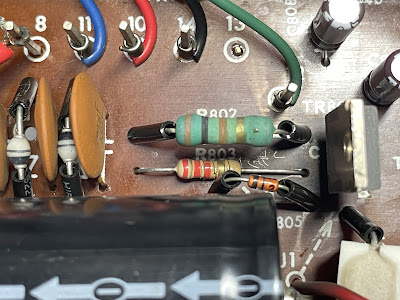
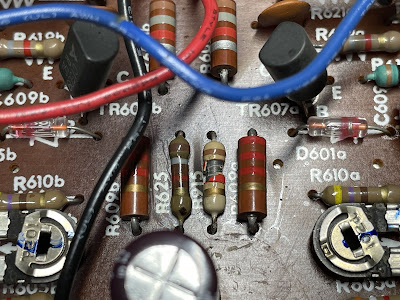

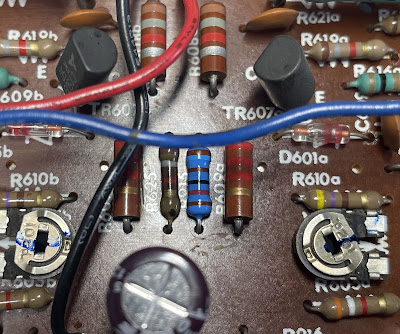

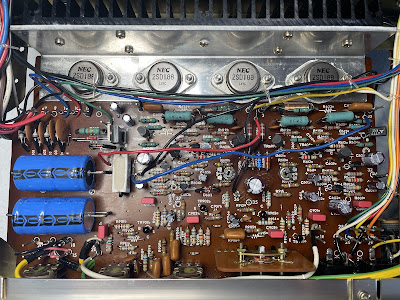


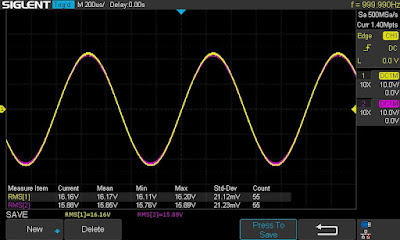


No comments:
Post a Comment